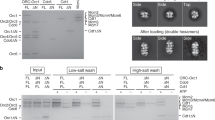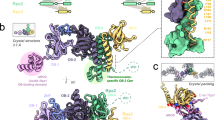Abstract
In bacteria, the initiation of replication is controlled by DnaA, a member of the ATPases associated with various cellular activities (AAA+) protein superfamily. ATP binding allows DnaA to transition from a monomeric state into a large oligomeric complex that remodels replication origins, triggers duplex melting and facilitates replisome assembly. The crystal structure of AMP-PCP–bound DnaA reveals a right-handed superhelix defined by specific protein-ATP interactions. The observed quaternary structure of DnaA, along with topology footprint assays, indicates that a right-handed DNA wrap is formed around the initiation nucleoprotein complex. This model clarifies how DnaA engages and unwinds bacterial origins and suggests that additional, regulatory AAA+ proteins engage DnaA at filament ends. Eukaryotic and archaeal initiators also have the structural elements that promote open-helix formation, indicating that a spiral, open-ring AAA+ assembly forms the core element of initiators in all domains of life.
This is a preview of subscription content, access via your institution
Access options
Subscribe to this journal
Receive 12 print issues and online access
$189.00 per year
only $15.75 per issue
Buy this article
- Purchase on Springer Link
- Instant access to full article PDF
Prices may be subject to local taxes which are calculated during checkout







Similar content being viewed by others
Accession codes
References
Giraldo, R. Common domains in the initiators of DNA replication in Bacteria, Archaea and Eukarya: combined structural, functional and phylogenetic perspectives. FEMS Microbiol. Rev. 26, 533–554 (2003).
Iyer, L.M., Leipe, D.D., Koonin, E.V. & Aravind, L. Evolutionary history and higher order classification of AAA+ ATPases. J. Struct. Biol. 146, 11–31 (2004).
Erzberger, J.P. & Berger, J.M. Evolutionary relationships and structural mechanisms of AAA+ proteins. Annu. Rev. Biophys. Biomol. Struct. 35, 93–114 (2006).
Robinson, N.P. & Bell, S.D. Origins of DNA replication in the three domains of life. FEBS J. 272, 3757–3766 (2005).
Lee, D.G. & Bell, S.P. ATPase switches controlling DNA replication initiation. Curr. Opin. Cell Biol. 12, 280–285 (2000).
Messer, W. The bacterial replication initiator DnaA. DnaA and oriC, the bacterial mode to initiate DNA replication. FEMS Microbiol. Rev. 26, 355–374 (2002).
Leonard, A.C. & Grimwade, J.E. Building a bacterial orisome: emergence of new regulatory features for replication origin unwinding. Mol. Microbiol. 55, 978–985 (2005).
Funnell, B.E., Baker, T.A. & Kornberg, A. In vitro assembly of a prepriming complex at the origin of the Escherichia coli chromosome. J. Biol. Chem. 262, 10327–10334 (1987).
Davey, M.J., Fang, L., McInerney, P., Georgescu, R.E. & O'Donnell, M. The DnaC helicase loader is a dual ATP/ADP switch protein. EMBO J. 21, 3148–3159 (2002).
Fang, L., Davey, M.J. & O'Donnell, M. Replisome assembly at oriC, the replication origin of E. coli, reveals an explanation for initiation sites outside an origin. Mol. Cell 4, 541–553 (1999).
Kato, J. & Katayama, T. Hda, a novel DnaA-related protein, regulates the replication cycle in Escherichia coli. EMBO J. 20, 4253–4262 (2001).
Fujikawa, N. et al. Structural basis of replication origin recognition by the DnaA protein. Nucleic Acids Res. 31, 2077–2086 (2003).
Mackiewicz, P., Zakrzewska-Czerwinska, J., Zawilak, A., Dudek, M.R. & Cebrat, S. Where does bacterial replication start? Rules for predicting the oriC region. Nucleic Acids Res. 32, 3781–3791 (2004).
Cunningham, E.L. & Berger, J.M. Unraveling the early steps of prokaryotic replication. Curr. Opin. Struct. Biol. 15, 68–76 (2005).
Bowman, G.D., O'Donnell, M. & Kuriyan, J. Structural analysis of a eukaryotic sliding DNA clamp-clamp loader complex. Nature 429, 724–730 (2004).
Jeruzalmi, D., O'Donnell, M. & Kuriyan, J. Crystal structure of the processivity clamp loader gamma (gamma) complex of E. coli DNA polymerase III. Cell 106, 429–441 (2001).
Erzberger, J.P., Pirruccello, M.M. & Berger, J.M. The structure of bacterial DnaA: implications for general mechanisms underlying DNA replication initiation. EMBO J. 21, 4763–4773 (2002).
Lee, S.Y. et al. Regulation of the transcriptional activator NtrC1: structural studies of the regulatory and AAA+ ATPase domains. Genes Dev. 17, 2552–2563 (2003).
Guo, F., Maurizi, M.R., Esser, L. & Xia, D. Crystal structure of ClpA, an Hsp100 chaperone and regulator of ClpAP protease. J. Biol. Chem. 277, 46743–46752 (2002).
Lenzen, C.U., Steinmann, D., Whiteheart, S.W. & Weis, W.I. Crystal structure of the hexamerization domain of N-ethylmaleimide-sensitive fusion protein. Cell 94, 525–536 (1998).
Yu, R.C., Hanson, P.I., Jahn, R. & Brunger, A.T. Structure of the ATP-dependent oligomerization domain of N-ethylmaleimide sensitive factor complexed with ATP. Nat. Struct. Biol. 5, 803–811 (1998).
Felczak, M.M. & Kaguni, J.M. The box VII motif of Escherichia coli DnaA protein is required for DnaA oligomerization at the E. coli replication origin. J. Biol. Chem. 279, 51156–51162 (2004).
Kawakami, H., Keyamura, K. & Katayama, T. Formation of an ATP-DnaA-specific initiation complex requires DnaA Arginine 285, a conserved motif in the AAA+ protein family. J. Biol. Chem. 280, 27420–27430 (2005).
Su'etsugu, M. et al. DNA replication-coupled inactivation of DnaA protein in vitro: a role for DnaA arginine-334 of the AAA+ Box VIII motif in ATP hydrolysis. Mol. Microbiol. 40, 376–386 (2001).
Bramhill, D. & Kornberg, A. A model for initiation at origins of DNA replication. Cell 54, 915–918 (1988).
Thanbichler, M., Viollier, P.H. & Shapiro, L. The structure and function of the bacterial chromosome. Curr. Opin. Genet. Dev. 15, 153–162 (2005).
Postow, L., Hardy, C.D., Arsuaga, J. & Cozzarelli, N.R. Topological domain structure of the Escherichia coli chromosome. Genes Dev. 18, 1766–1779 (2004).
Fuller, R.S., Funnell, B.E. & Kornberg, A. The dnaA protein complex with the E. coli chromosomal replication origin (oriC) and other DNA sites. Cell 38, 889–900 (1984).
Speck, C. & Messer, W. Mechanism of origin unwinding: sequential binding of DnaA to double- and single-stranded DNA. EMBO J. 20, 1469–1476 (2001).
McGarry, K.C., Ryan, V.T., Grimwade, J.E. & Leonard, A.C. Two discriminatory binding sites in the Escherichia coli replication origin are required for DNA strand opening by initiator DnaA-ATP. Proc. Natl. Acad. Sci. USA 101, 2811–2816 (2004).
Yung, B.Y. & Kornberg, A. The dnaA initiator protein binds separate domains in the replication origin of Escherichia coli. J. Biol. Chem. 264, 6146–6150 (1989).
Gai, D., Zhao, R., Li, D., Finkielstein, C.V. & Chen, X.S. Mechanisms of conformational change for a replicative hexameric helicase of SV40 large tumor antigen. Cell 119, 47–60 (2004).
Marszalek, J. & Kaguni, J.M. DnaA protein directs the binding of DnaB protein in initiation of DNA replication in Escherichia coli. J. Biol. Chem. 269, 4883–4890 (1994).
Su'etsugu, M., Takata, M., Kubota, T., Matsuda, Y. & Katayama, T. Molecular mechanism of DNA replication-coupled inactivation of the initiator protein in Escherichia coli: interaction of DnaA with the sliding clamp-loaded DNA and the sliding clamp-Hda complex. Genes Cells 9, 509–522 (2004).
Su'etsugu, M., Shimuta, T.R., Ishida, T., Kawakami, H. & Katayama, T. Protein associations in DnaA-ATP hydrolysis mediated by the Hda-replicase clamp complex. J. Biol. Chem. 280, 6528–6536 (2005).
Marszalek, J. et al. Domains of DnaA protein involved in interaction with DnaB protein, and in unwinding the Escherichia coli chromosomal origin. J. Biol. Chem. 271, 18535–18542 (1996).
Sutton, M.D., Carr, K.M., Vicente, M. & Kaguni, J.M. Escherichia coli DnaA protein. The N-terminal domain and loading of DnaB helicase at the E. coli chromosomal origin. J. Biol. Chem. 273, 34255–34262 (1998).
Kelman, L.M. & Kelman, Z. Archaea: an archetype for replication initiation studies? Mol. Microbiol. 48, 605–615 (2003).
Remus, D., Beall, E.L. & Botchan, M.R. DNA topology, not DNA sequence, is a critical determinant for Drosophila ORC-DNA binding. EMBO J. 23, 897–907 (2004).
Takahashi, N., Tsutsumi, S., Tsuchiya, T., Stillman, B. & Mizushima, T. Functions of sensor 1 and sensor 2 regions of Saccharomyces cerevisiae Cdc6p in vivo and in vitro. J. Biol. Chem. 277, 16033–16040 (2002).
Randell, J.C., Bowers, J.L., Rodriguez, H.K. & Bell, S.P. Sequential ATP hydrolysis by Cdc6 and ORC directs loading of the Mcm2–7 helicase. Mol. Cell 21, 29–39 (2006).
Ranjan, A. & Gossen, M. A structural role for ATP in the formation and stability of the human origin recognition complex. Proc. Natl. Acad. Sci. USA 103, 4864–4869 (2006).
Clarey et al. Nucleotide-dependent conformational changes in the DnaA-like core of the origin-recognition complex. Nat. Struct. Mol. Biol. advance online publication 9 July 2006 (doi: 10.1038/nsmb1121).
Otwinowski, Z. & Minor, W. Processing of X-ray diffraction data collected in oscillation mode. Methods Enzymol. 276, 472–494 (1997).
Read, R.J. Pushing the boundaries of molecular replacement with maximum likelihood. Acta Crystallogr. D Biol. Crystallogr. 57, 1373–1382 (2001).
Brunger, A.T. et al. Crystallography & NMR system: a new software suite for macromolecular structure determination. Acta Crystallogr. D Biol. Crystallogr. 54, 905–921 (1998).
Terwilliger, T.C. Maximum-likelihood density modification. Acta Crystallogr. D Biol. Crystallogr. 56, 965–972 (2000).
Jones, T.A., Zou, J.Y., Cowan, S.W. & Kjeldgaard, M. Improved methods for building protein models in electron density maps and the location of errors in these models. Acta Crystallogr. A 47, 110–119 (1991).
Lamzin, V.S. & Wilson, K.S. Automated refinement of protein models. Acta Crystallogr. D Biol. Crystallogr. 49, 129–147 (1993).
Glaser, F. et al. ConSurf: identification of functional regions in proteins by surface-mapping of phylogenetic information. Bioinformatics 19, 163–164 (2003).
Nielsen, J.E. et al. Improving macromolecular electrostatics calculations. Protein Eng. 12, 657–662 (1999).
Acknowledgements
We thank J. Holton and J. Tanamachi for support at Advanced Light Source beamline 8.3.1 and A. Schoeffler for purifying Topo IB. N. Cozzarelli, M. Botchan, J. Kuriyan, J. Keck, J. Stray and members of the Berger laboratory provided helpful comments and suggestions. This work was supported by the G. Harold and Leila Y. Mathers Charitable Foundation and the US National Institutes of Health (GM071747).
Author information
Authors and Affiliations
Corresponding author
Ethics declarations
Competing interests
The authors declare no competing financial interests.
Supplementary information
Supplementary Fig. 1
Representative electron density. (PDF 725 kb)
Supplementary Fig. 2
Aquifex aeolicus origin organization. (PDF 77 kb)
Supplementary Fig. 3
Surface characteristics of the ATP-DnaA filament. (PDF 404 kb)
Supplementary Video 1
Filament structure. (MOV 11654 kb)
Supplementary Video 2
Animation of ADP-to-ATP transition. (MOV 18017 kb)
Rights and permissions
About this article
Cite this article
Erzberger, J., Mott, M. & Berger, J. Structural basis for ATP-dependent DnaA assembly and replication-origin remodeling. Nat Struct Mol Biol 13, 676–683 (2006). https://doi.org/10.1038/nsmb1115
Received:
Accepted:
Published:
Issue Date:
DOI: https://doi.org/10.1038/nsmb1115
This article is cited by
-
Robust replication initiation from coupled homeostatic mechanisms
Nature Communications (2022)
-
The AAA + ATPase TorsinA polymerizes into hollow helical tubes with 8.5 subunits per turn
Nature Communications (2019)
-
Structures, functions, and mechanisms of filament forming enzymes: a renaissance of enzyme filamentation
Biophysical Reviews (2019)
-
Iron chelation increases the tolerance of Escherichia coli to hyper-replication stress
Scientific Reports (2018)
-
Countermeasures to survive excessive chromosome replication in Escherichia coli
Current Genetics (2018)



